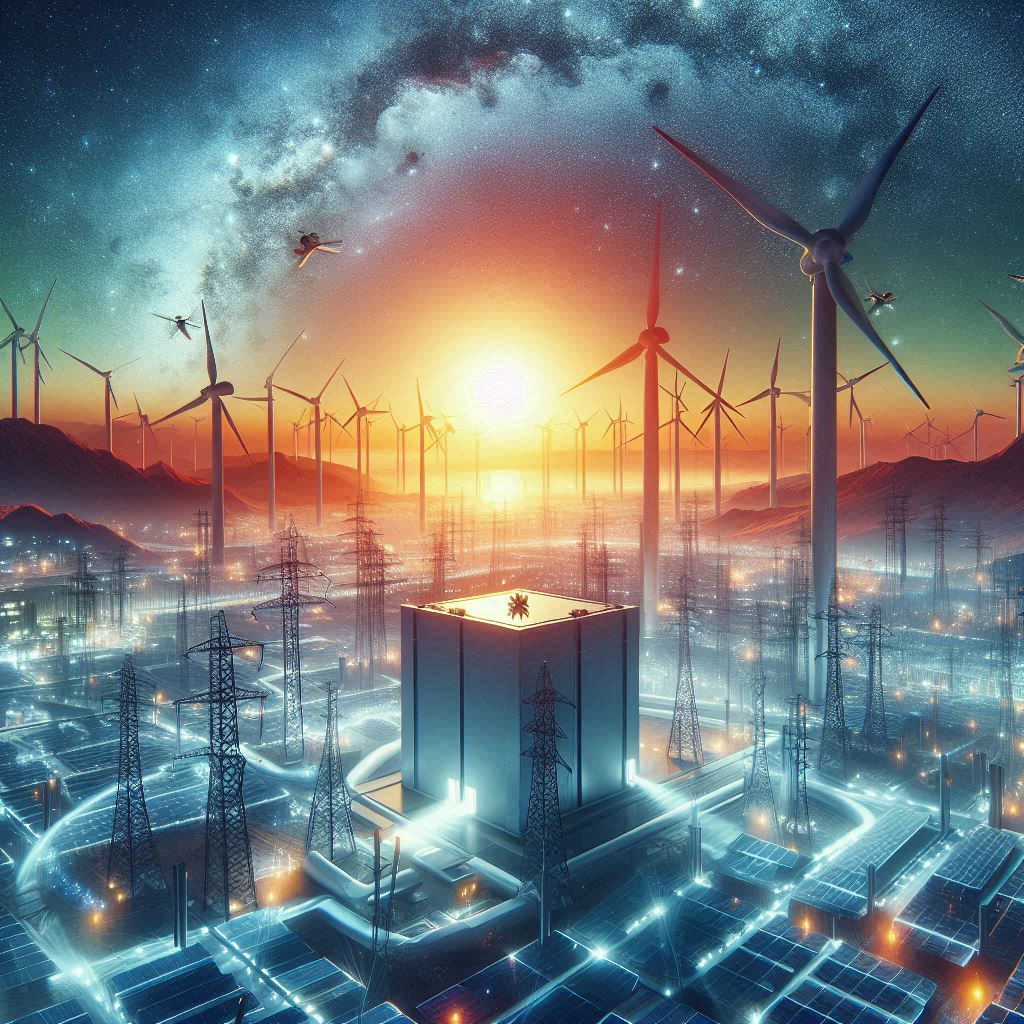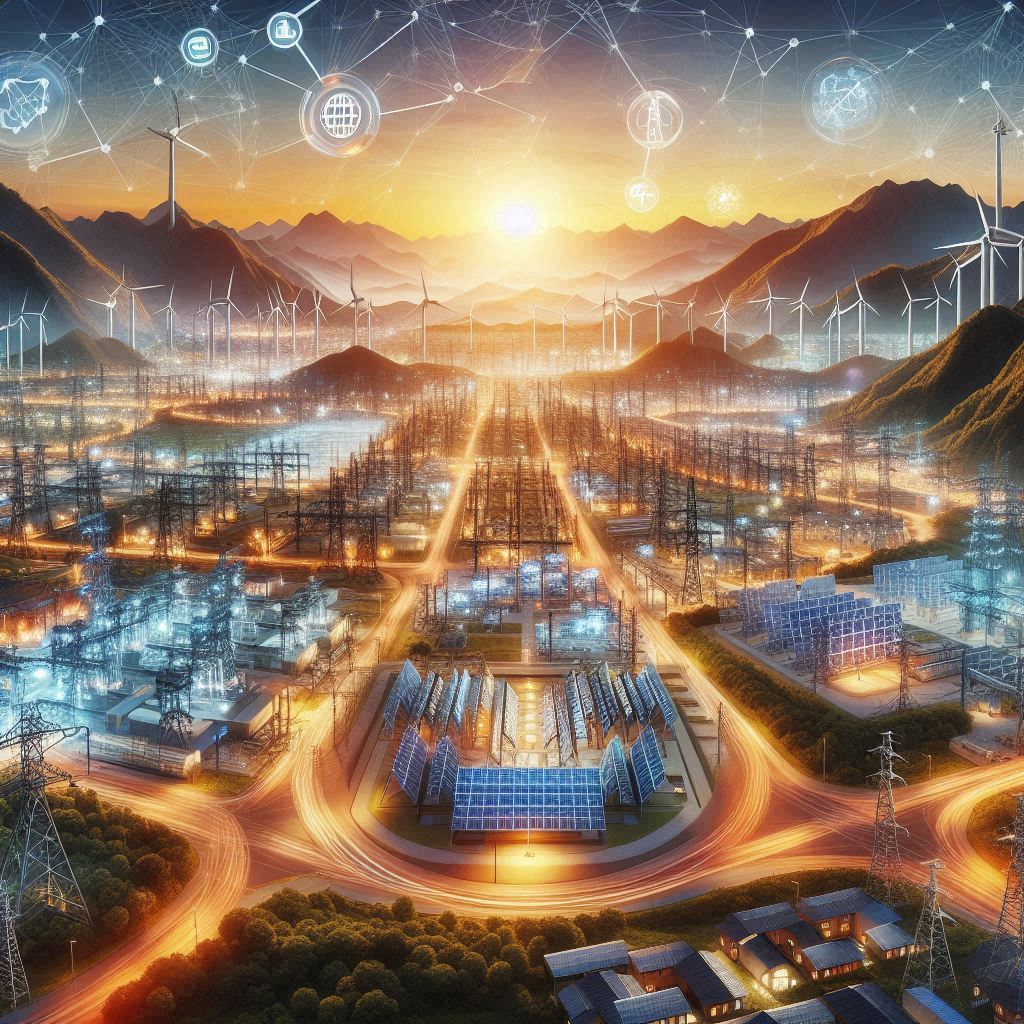There are many outstanding questions in energy and climate that Artificial Intelligence could help address. These are some important ones:
Energy Transition and Renewables:

Cost and Scalability of Renewables: Can renewable energy sources like solar and wind become truly cost-competitive with fossil fuels at the scale needed to power a global economy?
AI agents can be powerful tools in evaluating the cost and scalability of renewables compared to fossil fuels. Here’s how:
Data Analysis:
- Massive Data Processing: AI agents can analyze vast amounts of historical and real-time data on:
- Renewable energy costs (solar panel prices, wind turbine construction)
- Fossil fuel costs (extraction, transportation, refining)
- Energy consumption patterns
- Geographic resource availability (sunlight, wind patterns)
- Identifying Trends and Patterns: AI agents can identify trends in data, such as the historical decline in renewable energy costs and potential future cost reductions with technological advancements.
Modeling and Forecasting:
- Simulating Different Scenarios: AI can agents create complex models to simulate how factors like government policies, technological breakthroughs, and climate change might impact the cost and scalability of renewables compared to fossil fuels.
- Predicting Future Costs: AI agents can be used to forecast the future cost of both renewable and fossil fuel energy sources, considering various economic and technological factors.
- Identifying Optimal Solutions: AI agents can analyze different scenarios and identify optimal solutions for scaling up renewable energy at the lowest possible cost.
Optimization and Efficiency:
- Grid Management: AI agents can be used to optimize energy grids for integrating large-scale renewable energy sources that are intermittent (solar, wind). This can involve optimizing power storage solutions and grid balancing strategies.
- Optimizing Siting and Deployment: AI agents can analyze data to identify optimal locations for new solar and wind farms, maximizing energy production and minimizing environmental impact.
- Maintenance and Repair: AI agents can be used to analyze sensor data from renewable energy infrastructure to predict maintenance needs and optimize repair schedules, reducing downtime and costs.

Energy Storage Solutions: How can we develop efficient and affordable large-scale energy storage solutions to balance the intermittent nature of renewables?
AI agents can be instrumental in addressing the challenge of developing efficient and affordable large-scale energy storage solutions for renewables. Here’s how:
1. Optimizing Existing Storage Technologies:
- Machine Learning for Battery Management: AI agents can be used to develop machine learning algorithms for Battery Management Systems (BMS) that optimize charging and discharging cycles. This can extend battery life, improve efficiency, and minimize degradation.
- Predictive Maintenance: AI agents can analyze sensor data from storage systems to predict potential failures and schedule preventative maintenance, reducing downtime and costs.
2. Identifying and Developing New Storage Solutions:
- Material Science & Design: AI agents can analyze vast datasets on materials science to identify novel materials with higher energy density or faster charging capabilities for future battery technologies.
- Simulating New Storage Technologies: AI agents can be used to model and simulate the performance of new storage technologies, such as pumped hydro storage or compressed air energy storage, under various operating conditions.
3. Integrating Storage with Renewables and the Grid:
- Smart Grid Management: AI agents can optimize energy grids in real-time, accounting for the variable output of renewables and the capacity of storage facilities. This can improve grid stability and reduce the need for fossil fuel backup power.
- Demand Forecasting: AI agents can analyze historical and real-time data to forecast energy demand, allowing for strategic charging and discharging of stored energy to meet peak demand periods.
4. Cost Optimization and Market Analysis:
- Identifying Cost Reduction Opportunities: AI agents can analyze data on manufacturing processes and materials to identify opportunities for cost reduction in existing and future storage technologies.
- Market Analysis and Deployment Strategies: AI agents can analyze market trends and predict future energy needs, informing the development and deployment of large-scale storage solutions where they are most needed.

Grid Integration: How can we effectively integrate a diverse mix of renewable energy sources into existing electricity grids, maintaining reliability and affordability?
AI agents can significantly aid in effectively integrating a diverse mix of renewable energy sources into existing electricity grids while maintaining reliability and affordability. Here’s how:
1. Real-Time Optimization and Grid Management:
- Forecasting and Prediction: AI agents can analyze historical and real-time data on weather patterns, energy consumption, and renewable energy output. This allows for short-term and long-term forecasting of energy needs and renewable energy production.
- Dispatch Optimization: AI agents can optimize the dispatch of different energy sources (renewables, fossil fuels, storage) based on real-time forecasts and grid conditions. This ensures efficient power generation and minimizes reliance on expensive peak power plants.
- Congestion Management: AI agents can identify potential congestion points in the grid caused by fluctuating renewable energy and suggest mitigation strategies, such as rerouting power flow or activating distributed energy resources.
2. Integration of Distributed Energy Resources (DERs):
- DER Management: AI agents can optimize the operation of DERs like rooftop solar panels and electric vehicles, allowing them to inject power into the grid or draw power strategically to balance supply and demand.
- Microgrid Management: AI agents can manage microgrids, localized grids with a mix of generation and consumption, optimizing their operation within the larger grid framework.
3. Planning and Infrastructure Investment:
- Grid Expansion and Reinforcement: AI agents can analyze data to identify areas in the grid that require upgrades or expansion to accommodate increased renewable energy integration.
- Cost-Benefit Analysis: AI agents can perform cost-benefit analyses of different grid modernization strategies, considering factors like efficiency gains, infrastructure costs, and long-term benefits of renewable energy integration.
4. Cybersecurity and Resilience:
- Threat Detection and Prevention: AI agents can analyze grid data to identify potential cyberattacks and system vulnerabilities, improving grid security and resilience.
- Self-Healing Grids: AI agents can be used to develop self-healing grids that can automatically identify and reroute power around outages or disruptions, minimizing downtime and impact on consumers.

Next-Generation Renewables: What breakthroughs are needed to make emerging renewable technologies, like geothermal and ocean energy, commercially viable on a large scale?
AI agents can be powerful allies in the quest to make next-generation renewable technologies like geothermal and ocean energy commercially viable on a large scale. Here’s how:
1. Resource Exploration and Site Selection:
- Data Analysis and Machine Learning: AI agents can analyze vast datasets on geological formations, ocean currents, and wave patterns to identify promising locations for geothermal and ocean energy projects. This can save time and resources compared to traditional exploration methods.
- Predictive Modeling: AI agents can be used to predict the potential energy output and long-term viability of geothermal and ocean energy projects at specific locations.
2. Technological Innovation and Optimization:
- Material Science & Design: AI agents can analyze vast datasets on materials science to identify new materials with better heat tolerance, corrosion resistance, or energy conversion efficiency for geothermal and ocean energy technologies.
- Simulating New Technologies: AI agents can be used to simulate and optimize the design of new technologies for harnessing geothermal and ocean energy, such as advanced heat exchangers or wave energy converters.
3. Cost Reduction and Economic Modeling:
- Identifying Cost Reduction Opportunities: AI agents can analyze data on manufacturing processes and materials to identify areas for cost reduction in existing and future geothermal and ocean energy technologies.
- Economic Viability Assessment: AI agents can model the economic feasibility of geothermal and ocean energy projects, considering factors like capital costs, energy production estimates, and potential government incentives.
4. Environmental Impact Assessment:
- Minimizing Environmental Footprint: AI agents can be used to model and assess the potential environmental impact of geothermal and ocean energy projects, suggesting strategies to minimize risks and optimize project sustainability.

Climate Impacts and Feedback Loops:
Climate Sensitivity: How much will global temperatures rise for a given increase in greenhouse gas emissions? Are there tipping points or feedback loops we don’t fully understand?
AI agents can be powerful tools in helping us understand climate sensitivity, the complex relationship between greenhouse gas emissions and global temperature rise. Here’s how:
1. Analyzing Massive Datasets:
- Climate Modeling: AI agents can analyze vast amounts of climate data, including historical temperature records, atmospheric composition data, and oceanographic data. This data can be used to train complex climate models that simulate how the Earth’s climate system responds to changes in greenhouse gas concentrations.
- Identifying Trends and Patterns: AI agents can identify subtle trends and patterns in climate data that might be missed by traditional analysis methods. These insights can improve the accuracy of climate models and our understanding of climate sensitivity.
2. Exploring Different Scenarios:
- Simulating Climate Futures: AI agents can be used to run simulations of future climate scenarios based on different levels of greenhouse gas emissions. This allows scientists to explore potential outcomes and assess the risks associated with exceeding certain tipping points.
- Identifying Feedback Loops: AI agents can analyze climate models to identify potential feedback loops, where a warming climate triggers further warming processes (e.g., melting permafrost releasing methane). Understanding these loops is crucial for accurate climate predictions.
3. Early Warning Systems:
- Tipping Point Detection: AI agents can be used to analyze climate data in real-time to identify early warning signs of potential tipping points in the Earth’s climate system. This can provide valuable time for policymakers to take action and mitigate the worst effects of climate change.
- Risk Assessment: AI agents can be used to assess the risks associated with different climate change scenarios, informing decision-making on mitigation and adaptation strategies.
There are many other questions that AI agents can help address:
Sea Level Rise Projections: How quickly will sea levels rise in the coming decades, and what are the implications for coastal communities and infrastructure?
Extreme Weather Events: How will climate change affect the frequency and intensity of extreme weather events like heatwaves, droughts, floods, and hurricanes?
Ocean Acidification: What are the long-term impacts of ocean acidification on marine ecosystems and the global carbon cycle?
Policy and Societal Challenges:
Carbon Capture and Storage (CCS): Can CCS technology be developed and deployed effectively to capture and store carbon emissions from power plants and industrial facilities?
Geoengineering Solutions: What are the ethical and environmental risks associated with potential geoengineering solutions to mitigate climate change?
Just Transition: How can we ensure a just transition to a low-carbon economy that protects workers and communities reliant on fossil fuels?
International Cooperation: How can we achieve effective international cooperation on climate action, considering the diverse economic and political interests of different countries?
Technological Advancements:
Advanced Nuclear Reactors: Can next-generation nuclear reactor designs address safety and waste disposal concerns, making them a viable option for low-carbon energy production?
Fusion Power: When and how will we achieve commercially viable fusion power, a potential source of clean and limitless energy?
Negative Emissions Technologies: Can technologies be developed that remove existing carbon dioxide from the atmosphere at scale and at an affordable cost?
Climate System Modeling and Prediction:
Climate Model Uncertainty: How can we reduce the uncertainty in climate models to provide more accurate projections of future climate change?
Regional Climate Impacts: How can we improve the ability of climate models to predict regional climate impacts with greater detail and accuracy?
Social and Behavioral Change:
Public Perception of Climate Change: How can we effectively communicate the science of climate change and encourage public engagement with climate solutions?
Consumer Behavior and Energy Efficiency: How can we encourage consumers to adopt energy-efficient technologies and behaviors to reduce their carbon footprint?
Building a Sustainable Future: How can we develop economic and social systems that prioritize sustainability and environmental responsibility?
One mission of Centaurs Fabs is to develop AI Agents that can assist energy and climate professionals to address these difficult but important questions.
To learn more on AI and energy you can watch this video:

